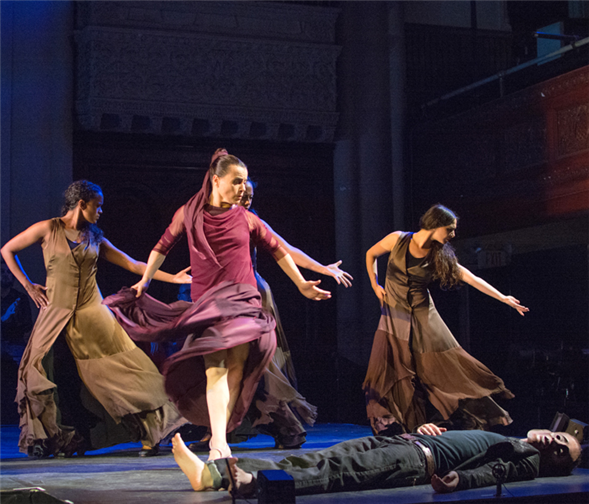Translate Page

At one moment during Antigona, Noche Flamenco's adaptation of Sophocles' Antigone, the chorus leader commands, "Let us dance and sing in the face of tragedy." Martín Santangelo and Soledad Barrio have taken Sophocles' command literally. In their Spanish-language version of the Greek tragedy, Antigone does not merely lament. She dances, ferociously, a Spanish flamenco.
At first look, Greek tragedy and Spanish flamenco may seem like opposite art forms – one literary and solemn, the other gestural and passionate. But Santangelo, who adapted and directed Antigona, disagrees. Backstage at the West Park Presbyterian Church on West 86th Street, where the show runs through August 15, he says, "This production is probably much closer to how the Greeks did it, because they sang, danced, and played music in the productions. They didn't do it as a straight play."
And Sophocles' tragedy, about a young woman who defies a king and pays for it with her life, isn't just a parable about a far-off time and place. The inspiration for Antigona was Spanish judge Baltasar Garzón, who in 2010 called for the exhumation, identification, and proper burial of the 120,000 victims lying in the mass graves created under the dictatorship of Francisco Franco. Garzón was thrown out of Spain for his efforts. Santangelo, who is also Noche Flamenco's artistic director, saw a parallel between that event and Antigone, who is forbidden from burying her brother Polyneices after he is declared a traitor by Creon, the king of Thebes.
"Garzón was trying to do a gesture for humanity, and they disbarred him and they threw him out of Spain," Santangelo says. "And for me, it was the story of Antigone."
When it came time to adapt the play for dance, Santangelo could think of no better heroine than his frequent collaborator (and wife of 22 years): Bessie-winning flamenco dancer Soledad Barrio, who co-founded Noche Flamenca in 1993 with her husband. She plays Antigone during the show, and the historical inspiration for Antigona was one that had personal resonance for her.
{Image1}
"I connected very much with Antigone, as a woman," says Barrio, who does not speak English. (During the interview, Santangelo acted as her translator.) "My mother [and her family] lived through the post-Franco war; some of them died of starvation. But family was the unity. And that's what's important for Antigone. Also I have two daughters, so I understand the importance of family."
It is this visceral understanding of the conflict between the political and the personal that informs Barrio's choreography for the show. When Antigone is imprisoned in a cave by Creon, she dances an athletic solo that spans the entire stage, her arms stretched above her head, her shoes quickly thundering against the stage. At one point, she silently screams in Creon's ear. "Movement always comes from feeling," Barrio says. "First I have to know what has to be said, and then the movement comes to support what has to be said and what has to be felt. It's not to paint something pretty. Flamenco is very personal."
Yet flamenco is not the only style of dance showcased in Antigona. When Antigone's brothers Eteocles (Jose Jimenez) and Polyneices (Ray F. Davis) fight for the throne, they have a dance-off. It's a battle of styles, with Jimenez's clapping flamenco against Davis's modern hip-hop. "In flamenco, we've always traveled around the world and taken things from other cultures," Barrio says. "Dancers have stolen things from tap and jazz. With the brothers, we wanted to differentiate them." Adds Santangelo, "And Polyneices is the modern part of Thebes."
Flamenco also incorporates a singer and a guitar, which is why the cast for Antigona is made of dancers, singers, and musicians. While the chorus is played by dancers in skeletal masks, roles such as Creon and the chorus leader are performed by singers. They are accompanied by four musicians, playing guitar, percussion, electric guitar, and bass.
That confluence of song and dance is another reason why Antigona was such a mammoth task for Noche Flamenca. Santangelo had to translate Sophocles' text to Spanish (guided by an English translation by Dudley Fitts and Robert Fitzgerald) and then turn it into a song, known in flamenco as a cante, which has a different structure than Greek verse and contains wails that resemble Islamic chants. Antigona took four years to develop, with the music taking two years. The process, as Santangelo succinctly puts it, was "torture. You have to find a way to match the structure of a flamenco song. You can't dance without music."
But if Noche Flamenca did their job, audiences will understand the story of Antigone while feeling to their bones the overwhelming emotions of its characters. "There's nobody out there right now who can pull off something like this," enthuses Barrio about her husband's work on the Antigona. "Because it transcends flamenco, and yet it is flamenco."
Santangelo translates her remarks and then looks at her, surprised. "That's nice, thank you."
---
Diep Tran is a writer and editor based in New York City
Photos by Zarmik Moqtaderi. Top photo: Soledad Barrio (center) and the cast of Antigona.